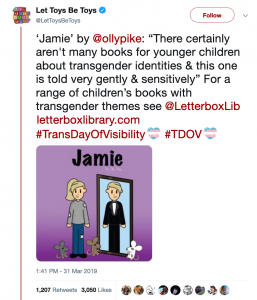
“We’re here to remind Stonewall what a lesbian is, on Lesbian Visibility Day. This is Stonewall’s supposed Workplace Equality Conference. There is no equality for women in the workplace when women are forced to pretend that men are also women. Stonewall gaslights lesbians. Stonewall promotes the censorship of women and exclusion of women from the workplace, and Stonewall forces women to share their private spaces with men.”
Julia Long
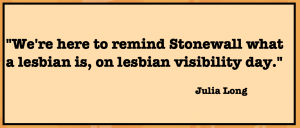
Lesbian Visibility Day originated in America and has been celebrated annually on April 26 since 2008.
Stonewall is the main LGBT organisation in the UK. It was founded in 1989 by a small group of people who had fought against Section 28. Their aim was to ‘create a professional lobbying group that would prevent such attacks on lesbians, gay and bi people from ever occurring again’.
In 2003 Stonewall was granted charitable status. Over the years Stonewall has fought successfully for many equality goals such as the equalisation of the age of consent, allowing lesbians and gay men to serve in the military, advocating for legalising civil partnerships and then for same-sex marriage. So you would be forgiven for thinking that Stonewall’s main focus on Lesbian Visibility Day (LVD) might have been lesbians.
But no. Stonewall’s Twitter banner on LVD sported an image of some burly sportsmen. Not a lesbian in sight.
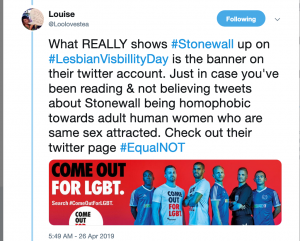
There’s a good reason for this. Lesbian and gay marriage became legal in the UK in 2014. In 2015, perhaps in need of a new battle, Stonewall became, in its own words, ‘trans inclusive’.
On Stonewall’s website you can download 13 posters to celebrate Trans Day of Visibility. I couldn’t find any posters for Lesbian Visibility Day, but it’s possible I didn’t look hard enough. Their 2017 video for LVD features a young woman who used to ‘define as’ lesbian but is now ‘non binary, gender fluid or gender queer’ and ex-Royal Marine transwoman Katie (nominated for a ‘Woman of the Year’ award) who is glad LVD validates his sexual orientation. The young woman who speaks last speaks of how “trans women, black women and working class women all make up our (lesbian) community.”
In an article for Stonewall’s Lesbian Day of Visibility this year, a young woman staff member writes “Claiming a lesbian identity was exciting and terrifying… I came out to my mom again this year when I told her I was non-binary and tried to explain I was still me and I was still a lesbian. Some people don’t understand how I can be both, but it’s not for those people to understand. My gender, my sexuality, they’re just that: mine.”
Another warns her fellow lesbians about the ‘wrong’ sort of lesbians. “..there are lesbians who wish to weaponise our sexuality against others in the community. Being a lesbian in 2019 to me means I can be proud and secure in my gender and sexuality and that doesn’t have to invalidate anyone else’s.”
Erin Walters-Williams in the same article writes about ‘living the lesbian dream’ but his Tweets on LVD made it pretty clear what he really thinks about women who are same-sex attracted.
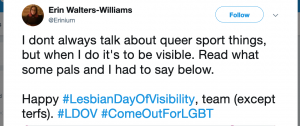
A third talks of how hard it is to accept lesbian as a label. “Even now it can make me feel uncomfortable” and another wears a ‘Some People are Queer’ TV shirt.
So much for same-sex attraction. In post-2015 Stonewall, there is no place for lesbians who define themselves as such. In post-2015 Stonewall, lesbians are problematic unless they are willing to accept men as women.
In fact, you might well have missed Lesbian day of Visibility altogether. Nobody even seems quite sure if it’s Lesbian Day of Visibility of Lesbian Visibility Day.
The Independent ran a short article celebrating LVD- with some interesting words in the link ‘lesbian-visibility-day-trans-rights-lgbt-terf’ and author Ella Braidwood made sure to include a reprimand to those who might want to exclude men from their lesbianism.
‘It’s also important to call out the disgraceful views of a small number of lesbians, who oppose rights for trans people and will try to hijack this Lesbian Visibility Day.’
So, lesbians who don’t believe men should have the right to call themselves lesbians are ‘disgraceful’ and are trying to ‘hijack’ that right from those men. Happy Lesbian Visibility Day indeed. Oh, the irony.
No wonder lesbians are pissed off.

The QEII (or QE2) centre at Westminster
Not only was Stonewall not putting much energy into celebrating LVD, but April 26th 2019 was the morning of its Workplace Equality Conference (or Coinference as some referred to it, tickets costing up to an eye-watering £514) and a group of lesbians and allies had gathered outside the QE2 centre in protest at what they view as Stonewall’s betrayal.
When I arrived at about ten thirty, most of the women were already there. We could see people milling around in the upstairs gallery, through the huge plate glass windows that lined the building.
Some women had attempted to fasten a banner to the railings behind them but had been ticked off by security, who made a half-hearted attempt to move them over onto the pavement. Janice had somehow managed to get inside the conference and was texting messages to people outside.
“I was just wandering around in there.” she told us later. “I sat down near the stage: the microphones cover quite a big area so I was hoping to get up and do my shouting from there. At lunchtime I was pointing at you lot and I was saying to people ‘Oh, who are those protestors? They don’t look scary. They’re pro-lesbian. What’s going on?’ and trying to get some discussion going. People were saying ‘Oh, I don’t know,’ and looking curious. I think somebody must have said something about me, they recognised me and I could see security were going to come over so I just started shouting at the top of my voice, ‘Transmen are women! Let lesbians be lesbians! Stop transing children! Transing children is child abuse! Transwomen are men. Science not ideology!’ and I kept on repeating those things. I walked around so people couldn’t stand in front of me and silence me. I was surprised they didn’t call security sooner. Then two big men came and I got carried out. I almost tripped one of them up as they moved me, but they were just doing their job really. I said to them ‘I know you’re just doing your job.‘ Then they put me in the lift. I shouted a bit more as the lift doors closed.”
We all clapped and cheered. Janice seemed unfazed by the experience and I was gobsmacked by both her bravery and good humour.
“We’re everywhere, Stonewall!” one woman called up to the conference room and everyone laughed again.
While Janice was seizing the moment inside, in the sunshine outside the other women had unfurled their banners and taken up position opposite the conference hall.
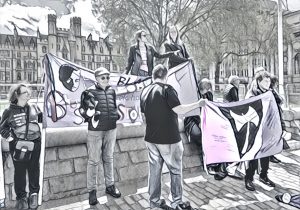
“Today is a day of lesbian visibility,” called out Julia. “We’re here to remind Stonewall what a lesbian is because Stonewall has forgotten. Get the L out of LGBT. Stonewall has betrayed lesbians. Get both the Ls out of Stonewall, so that it’s just Stone-waaaaa!”
Lesbian protestors and allies outside the Stonewall conference on Friday. “Get both the Ls out of Stonewall so it’s just Stonewaaaaaaaa!”😂 pic.twitter.com/JWhVjMX0g7
— Lily Maynard (@LilyLilyMaynard) April 29, 2019

“Shame on you wealthy corporations that send your delegates to do the work of male supremacy!” called Julia. “This is Stonewall’s agenda and you lot are swallowing it hook line and sinker. Shame on you Stonewall, and shame on you for attending!”
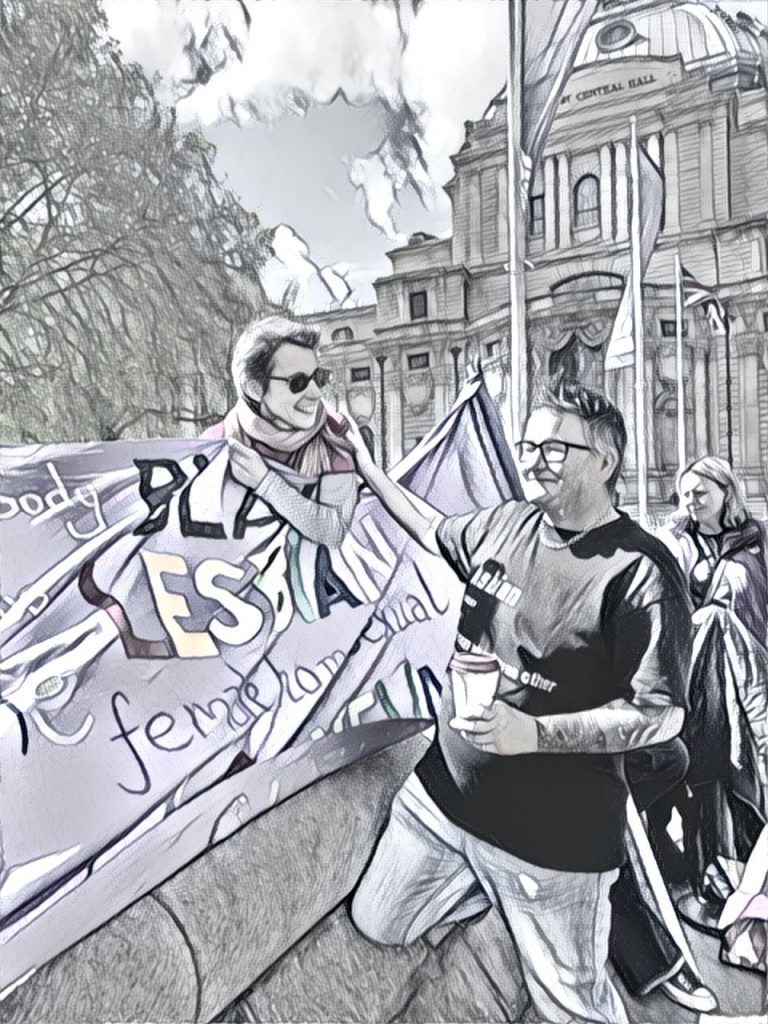
It seems astonishing that Stonewall would support a ideology that erases the age-old definition of being a lesbian, that a woman who loves women is a female homosexual, that she is same-sex attracted, not attracted to an elusive inner sense of gender identity that can be found lurking within a penis.
And yet here we are.
Here is the Stonewall definiton of a lesbian.

Nothing there about same sex attraction or being a female homosexual, so let’s have a look and see how they define woman.
Oh. They don’t.
But they do have a definition for transgender woman…

So can this person ‘assigned male at birth’ actually be a lesbian? Let’s ask Stonewall…

There’s your answer. Of course! Also, you can be a woman sometimes, if you want, or you can be neither a man or a woman. Stonewall believes that the right to self define as such, and to coerce those around you to comply with this self-declared transformation should be enshrined in law.
No wonder lesbians are pissed off.
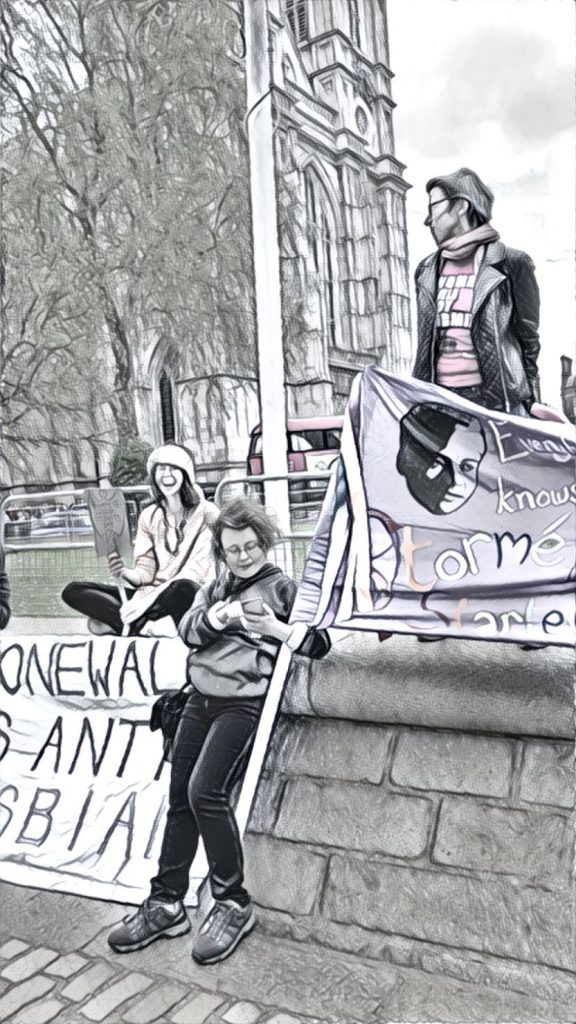
For lesbian women, those who supposedly lead the LGBT acronym adopted by Stonewall, this betrayal is vast, running somewhat along these lines:
‘First and foremost’ we need to redefine reality, change the meaning of words. Male bodied people can be women. Women can have penises. Lesbians can have penises. If a lesbian doesn’t want to have sex with someone purely on the grounds that they have a penis, she is transphobic.
This statement below, which would have been considered completely reasonable and rational just a few decades ago, is now seen as both transphobic and hateful.

No wonder lesbians are pissed off.

The mid morning break came and a few attendees stepped outside, mostly smokers. A police officer came over, very smiley and gentle, and reassured us that it was our right to protest, but that people inside the building had called the police. He said he could see we weren’t causing any trouble. He asked how long we were likely to be there and if we had a sound system. I was tempted to say that we didn’t need a sound system because we had Julia, but I told him no, we didn’t. He drifted off and some of us began handing leaflets out to passers by.

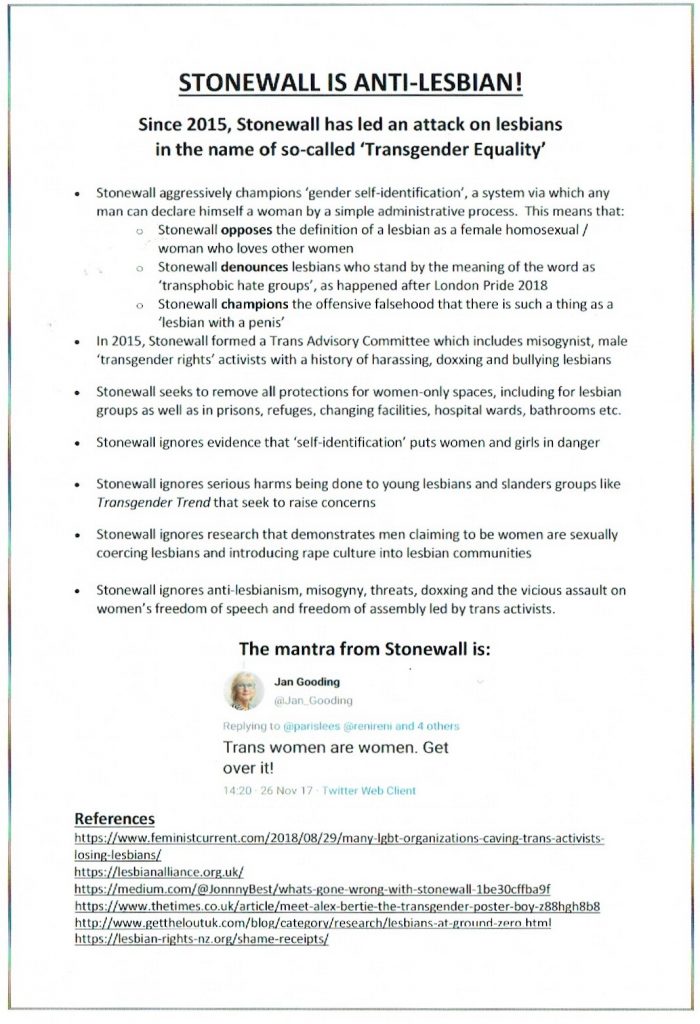
Some people smiled and seemed keen to read about what was going on. Others put their heads down, or shook them. I was happy to hand out leaflets; I got to coo over a couple of adorably cute babies, always a bonus of interacting with the public.
““It’s so lovely to have young lesbians join us,” said Sheila.
She sang a rousing chorus of ‘Maybe it’s because I’m a lesbian that I love women so,’ which I videoed and texted it to my daughter at uni who hadn’t yet got out of bed.
“Maybe it’s because I’m a lesbian
That I love women so
Maybe it’s because I’m a lesbian
That I think of them
Wherever I go.
I get a funny feeling inside of me
Just knowing they are near
Maybe it’s because I’m a lesbian
That I hold women dear
-get out the closet! –
that I hold women dear”
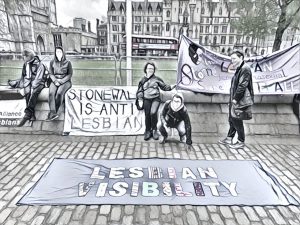
‘Happy Lesbian Visibility Day!‘ I texted Jessie.
‘OMG Queen’ she texted back.
The Lesbian Rights Alliance were there, and they also had a leaflet which they were handing out.
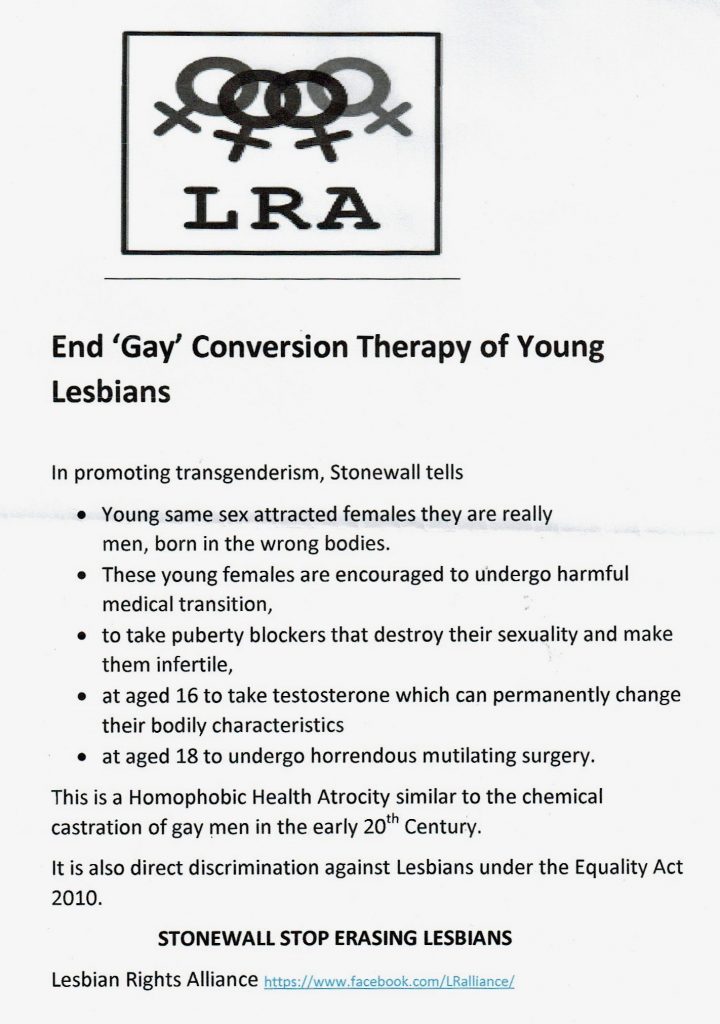
Lunchtime came. A group of conference attendees gathered by one of the exits. One of our number drifted over to them and was scolded crossly by a security guard ‘Go back over there! You’re not allowed over here!”
Two more police officers turned up, saying they had been called by people inside. They were polite and chatty. One told us he’d been on that beat for nearly 20 years. He said it was fine for us to be there. Hannah talked to him about netball.
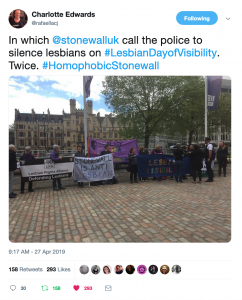
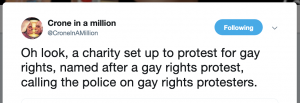
Dee and her friend spoke to two young women attending the conference. One looked nervous, saying, “Come on, let’s go, we don’t want to talk to them.” She scuttled away, but the other stayed.
‘I think what you’re doing is hateful,’ she told Dee.
Dee, of a similar age, explained how hard it had been for her growing up in Europe as a young lesbian, of the violence and bullying she had faced and how important the word ‘lesbian’ was to same-sex attracted women.
She was told in all seriousness that things weren’t so bad for lesbians any more.
“We cis women must support the most oppressed, and that’s transwomen, especially transwomen of colour.
I hope I’ve given you something to think about,” she concluded as she headed back into the building.
“Yes, I hope we’ve given you food for thought too,” replied Dee.
“Oh no,” the young woman laughed a little too lightly. “I won’t be changing my mind. I still think what you’re doing is hateful.”
Overhearing the exchange depressed me slightly.One thing the young woman had said stuck in my head.
“If we can’t agree on the definition of words, we can’t have a proper conversation.”
Yet whose fault is it if we can’t agree on the definition of words any more? Who has changed the definition of woman? Who has changed the definition of lesbian? You take away our words and then you say you can’t discuss it with us because they now have different meanings, and trying to reclaim the old ones is hateful and old-fashioned.
You take away our words.
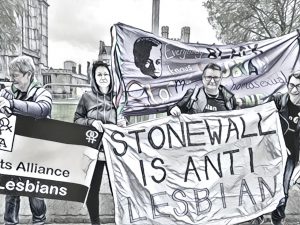
My pensiveness was broken by the realisation that some of the women had broken into a chorus of ‘Wonderwall’. Wonderwall? Why?
But it wasn’t ‘Wonderwall’. It was ‘Bonerwall’.
Today is gonna be the day that you finally understand
By now, they should’ve somehow realised that you’re just for trans
I can’t believe that any lesbians don’t realise the truth about you now.
Back beat, the word was on the street that the letter in your heart was T
I’m sure, they’ve heard it all before, you don’t care about the LGB
I can’t believe that any lesbian doesn’t feel the way I do about you now.
And all the links we ever shared are broken
Your hate’s in every word you’ve written or spoken
There are many things that I would like to say to you
and I’ll do that now
You’re traitors
You’re homophobes and betrayers
Cos after all, you are Boner Wall.”

Lunchtime came and went, and eventually so did we, off to the pub for well earned drinks and some lunch.
I had a vegan bean burger. It was delicious.



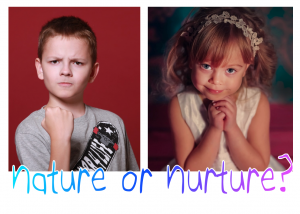
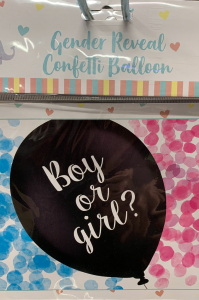 There are certainly some biological differences between girls and boys. Firstly, girls have XX chromosomes and boys have XY, except in very rare intersex conditions. You cannot change your chromosomes. It doesn’t matter if you like princesses or pirates, if archaeologists dig up your bones in two hundred years time, they’ll be able to tell if you were a man or a woman. It’s in your DNA. Girls and boys are born not only with different genitalia but with different hormone levels. But as the nature/nurture debate rages I become more and more convinced that boys and girls would have far fewer differences if we stopped shoving them into pink and blue boxes.
There are certainly some biological differences between girls and boys. Firstly, girls have XX chromosomes and boys have XY, except in very rare intersex conditions. You cannot change your chromosomes. It doesn’t matter if you like princesses or pirates, if archaeologists dig up your bones in two hundred years time, they’ll be able to tell if you were a man or a woman. It’s in your DNA. Girls and boys are born not only with different genitalia but with different hormone levels. But as the nature/nurture debate rages I become more and more convinced that boys and girls would have far fewer differences if we stopped shoving them into pink and blue boxes.

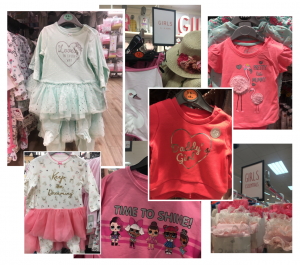
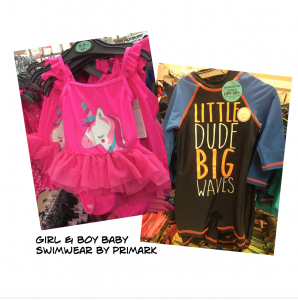
 Here are the girls’ magazines. They are pastel shades of pink, purple and baby blue, adorned with sparkles and a sprinkle of friendship and caring; the free gifts are cheap plastic jewellery, shiny secret notebooks and endless unicorn stickers. This week I saw no make up or nail polish, but it is not an uncommon free gift with these magazines.
Here are the girls’ magazines. They are pastel shades of pink, purple and baby blue, adorned with sparkles and a sprinkle of friendship and caring; the free gifts are cheap plastic jewellery, shiny secret notebooks and endless unicorn stickers. This week I saw no make up or nail polish, but it is not an uncommon free gift with these magazines. The boys’ magazines are bold in primary colours. The covers promise adventure and heroism inside; there are robot armies to be vanquished and villains to be thwarted; free gifts are badges and ‘epic’ puzzles but mostly gun-like apparatus for shooting frisbees or sponge balls.
The boys’ magazines are bold in primary colours. The covers promise adventure and heroism inside; there are robot armies to be vanquished and villains to be thwarted; free gifts are badges and ‘epic’ puzzles but mostly gun-like apparatus for shooting frisbees or sponge balls.



